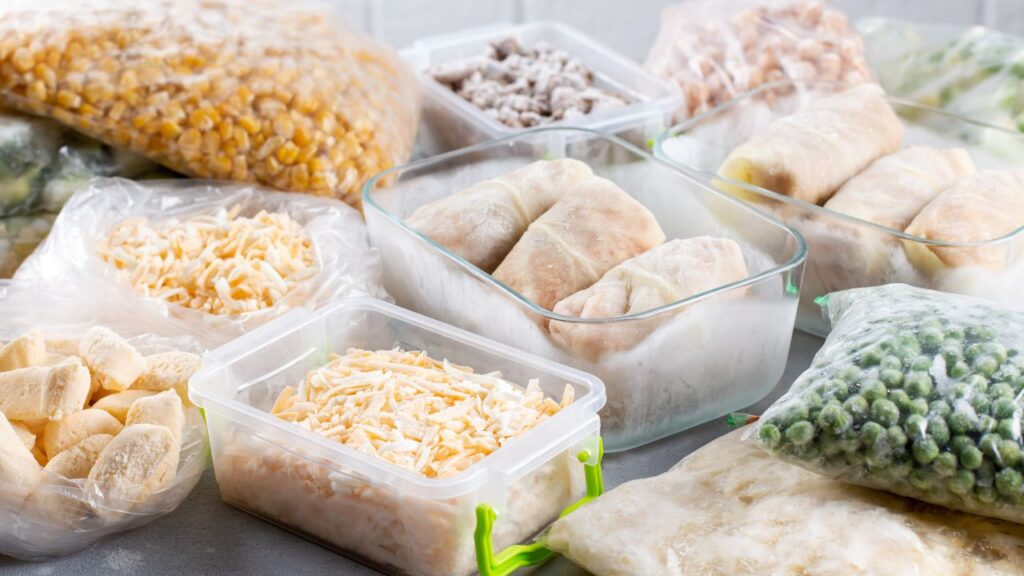
Traveling with frozen food might seem tricky, but trust me, it’s totally doable with the right approach. Whether you’re bringing home your favorite frozen treats, carrying homemade meals for a trip, or transporting frozen seafood across the country, knowing how to keep your food frozen while following airline and TSA rules is essential.
I’ve personally packed frozen food for flights multiple times, and while it requires some planning, it’s not as complicated as it sounds. The key is using the right packaging, choosing between carry-on or checked baggage wisely, and understanding TSA and airline policies.
In this guide, let’s learn how to travel with frozen food on a plane, including packing tips, regulations, and expert advice for a smooth journey. From packing techniques to navigating security checks, you’ll learn how to keep your frozen food in perfect condition throughout your journey.
Contents
- 1 TSA and Airline Regulations for Frozen Food
- 2 Best Ways to Pack Frozen Food for Air Travel
- 3 Carry-On vs. Checked Baggage: Which Is Better for Frozen Food?
- 4 Preparing for International Travel with Frozen Food
- 5 Understanding Customs Regulations
- 6 Airline Policies on International Travel
- 7 Food Safety Considerations for Long-Haul Flights
- 8 Special Considerations for Certain Countries
- 9 Conclusion: Successfully Traveling with Frozen Food
- 10 FAQ: Traveling with Frozen Food
TSA and Airline Regulations for Frozen Food
When it comes to flying with frozen food, the first thing you need to consider is TSA and airline regulations. While you’re allowed to bring frozen items on a plane, there are some important rules to follow to avoid problems at security or check-in.
TSA Rules for Carrying Frozen Food
The Transportation Security Administration (TSA) has clear guidelines on traveling with frozen food:
- Frozen food is allowed in both carry-on and checked luggage, as long as it remains completely frozen at the time of screening.
- If you’re using ice packs, gel packs, or dry ice, they must also be fully frozen when passing through security.
- Liquid-based frozen foods (like soups or sauces) must be solid at the time of screening; otherwise, they’ll be subject to the 3.4-ounce liquid rule.
💡 Pro Tip: Even if your food is slightly thawed, TSA might confiscate it, so ensure it’s solid before you reach the checkpoint.
Airline-Specific Guidelines
While TSA sets the baseline rules, individual airlines may have additional restrictions, especially when it comes to carrying dry ice in your luggage. Here’s what you need to check with your airline before flying:
- Dry Ice Limitations – Most airlines allow up to 5.5 lbs (2.5 kg) of dry ice in checked or carry-on luggage, but it must be in a ventilated container.
- Baggage Weight Limits – Frozen food can be heavy, so ensure your luggage doesn’t exceed the airline’s weight restrictions.
- International Travel Rules – Some airlines and countries ban certain frozen foods, like raw meat or dairy, due to agricultural regulations.
TSA vs. Airline Rules: Quick Comparison
| Aspect | TSA Rules | Airline-Specific Rules |
| Frozen Food | Allowed in carry-on and checked bags | No extra restrictions for most airlines |
| Gel Packs & Ice | Must be frozen solid at security | No restrictions unless melted |
| Dry Ice | Allowed (max 5.5 lbs), must be properly labeled | Some airlines require special approval |
| Liquid-Based Food | Must be fully frozen at screening | Follows TSA rules, but check international regulations |

Best Ways to Pack Frozen Food for Air Travel
Packing frozen food properly is the key to keeping it cold during your flight. Here’s everything you need to know to make sure your frozen food stays solid from the moment you pack it to the moment you arrive at your destination.
Choosing the Right Insulated Bags or Coolers
The first step in packing frozen food is selecting the right container. You want to ensure that the food is well insulated and able to stay frozen during the flight. Here are a few options:
- Insulated Cooler Bags – These are an excellent option for short flights or when you only need to keep your food frozen for a few hours. Look for bags with thick insulation and secure closures.
- Hard-sided Coolers – If you’re traveling with a larger amount of frozen food, a small, hard-sided cooler may be your best bet. These coolers offer extra insulation and protection for delicate foods.
- Thermal Food Containers – For smaller amounts, thermal food containers designed for keeping food cold can be a practical solution. These are often lighter and more compact than traditional coolers.
Using Dry Ice or Gel Packs
The next crucial step is ensuring that your food stays frozen throughout the flight. You can use a couple of different methods:
- Dry Ice – This is the best option for keeping food frozen for long flights. Dry ice stays much colder than regular ice and will keep your food solid for longer periods. However, you’ll need to follow TSA rules about dry ice (max 5.5 lbs per passenger), and it should be packed in a ventilated container. Always check your airline’s dry ice policy to avoid surprises.
- Gel Packs – These are a great alternative to dry ice if you’re not traveling with a large amount of food. Gel packs freeze at lower temperatures and stay cool for several hours. Just make sure they’re frozen solid before packing them into your cooler or bag.
💡 Pro Tip: For longer flights, bring extra gel packs or keep a few in your carry-on in case your frozen food starts to thaw.
Proper Packing Techniques
To maximize the cooling effect, you need to pack your food efficiently:
- Wrap Food Tightly – Ensure all frozen food is tightly wrapped to prevent any moisture from escaping. Vacuum-sealing is ideal for keeping food fresh and secure.
- Layer Ice or Gel Packs – Layer gel packs or dry ice around your food, not just on top. This will help keep the food evenly frozen during the flight.
- Pack Solid, Not Liquid – If you’re traveling with frozen liquids like soups or sauces, make sure they’re frozen solid before you leave. Liquid items that are partially thawed will be subject to TSA’s liquid restrictions.
Check Your Cooler for Air Tightness
If you’re using a cooler or insulated bag, double-check that the cooler is sealed properly. A tight seal helps maintain the cold temperature and prevents air from warming up the contents inside.
Carry-On vs. Checked Baggage: Which Is Better for Frozen Food?
Deciding whether to pack your frozen food in carry-on or checked baggage depends on several factors. Each option comes with its own set of benefits and challenges, so let’s break down which might be best for your specific needs.
Carry-On Baggage: The Pros and Cons
Pros of Carrying Frozen Food in Your Carry-On
- Control Over Your Food: One of the biggest advantages of packing frozen food in your carry-on is that you have more control over the condition of your food. You can keep an eye on it throughout the flight and ensure it stays properly chilled.
- Easier Access at Security: Carry-on items go through TSA security directly, so you won’t have to worry about your frozen food being subjected to mishandling in checked baggage.
- Shorter Handling Time: Since your carry-on doesn’t go through the long process of being loaded and unloaded from the plane, there’s less risk of your food thawing during handling.
Cons of Carrying Frozen Food in Your Carry-On
- Limited Space: Your carry-on has limited space, and frozen food can take up quite a bit of room, especially when packed with ice packs or dry ice.
- TSA Restrictions: Depending on the size and quantity of your frozen food, you might run into issues with TSA liquid rules or restrictions on dry ice.
- Weight Limit: Airlines often have strict weight limits for carry-on bags, so if you’re carrying frozen food along with other items, you might exceed your weight allowance.
Checked Baggage: The Pros and Cons
Pros of Packing Frozen Food in Checked Baggage
- More Space: Checked baggage gives you much more room to pack larger quantities of frozen food, which is ideal if you’re bringing a variety of items or need to transport a large cooler.
- Less Hassle at Security: Since the food doesn’t pass through TSA security with your personal belongings, you don’t have to worry about food being flagged for inspection or needing to follow liquid restrictions.
- No Size Restrictions: While carry-on bags have strict size limitations, you have more freedom with checked luggage to pack larger containers of frozen food.
Cons of Packing Frozen Food in Checked Baggage
- Risk of Thawing During Transit: Checked baggage is more likely to be delayed or subjected to more extreme temperature fluctuations, which increases the chance of your food thawing before you land.
- Less Control Over the Process: Once you hand off your checked luggage, you lose control over how it’s handled, and your food might not stay cold as long as you hope.
- Additional Charges: Some airlines charge extra fees for checked bags, especially if they exceed the weight limit. These fees can add up, especially if you’re traveling with a lot of frozen food.
Quick Comparison: Carry-On vs. Checked Baggage
| Aspect | Carry-On Baggage | Checked Baggage |
| Space | Limited space, best for small quantities | More space, ideal for larger or bulkier amounts of frozen food |
| Control | You can monitor your food during the flight | Less control over how the food is handled |
| TSA Restrictions | Must adhere to liquid and dry ice regulations | No liquid rules, but dry ice has specific requirements |
| Risk of Thawing | Less risk of thawing (shorter handling time) | Higher risk due to temperature fluctuations during transit |
| Weight Limit | May exceed the weight limit for carry-ons | Can carry heavier loads (up to the airline’s weight limit) |
Preparing for International Travel with Frozen Food
When you’re traveling internationally with frozen food, there are extra considerations you need to be aware of to avoid any complications. Between customs regulations, international airline policies, and potential food safety concerns, planning ahead is key. Let’s go over how to prepare for the journey and what to expect when you’re crossing borders with frozen food.

Understanding Customs Regulations
One of the biggest challenges when traveling internationally with frozen food is customs regulations. Each country has its own rules regarding what food items can be brought in and what can’t. Here are some general guidelines to follow:
- Research Destination Country’s Rules: Before you travel, check the customs website or contact the consulate of the country you’re visiting to find out their rules regarding food imports. Some countries have strict bans on bringing in meat, dairy, or other perishable goods, while others may allow it under certain conditions.
- Declare Your Food: Always declare any food items you’re carrying on the customs declaration form when you arrive in a new country. Failing to do so can result in fines, confiscation, or delays.
- Know What’s Banned: Common food items that are often banned include meats, fruits, vegetables, and dairy products, but the restrictions can vary widely by country. It’s essential to be familiar with the specific rules for the destination you’re traveling to.
Airline Policies on International Travel
When flying internationally with frozen food, airlines may have different policies compared to domestic flights. Here are a few things to keep in mind:
- Check Airline Restrictions: Each airline has specific guidelines for traveling with frozen food, and they may vary depending on the destination. Be sure to check your airline’s website or contact customer service to clarify what frozen food can be packed, how much dry ice is allowed, and whether additional charges apply.
- Size and Weight Restrictions: International flights often have stricter size and weight restrictions for checked baggage. Make sure your frozen food is packed in a way that meets the airline’s regulations, and be prepared for additional fees if your luggage is heavier than expected.
- Longer Travel Time: With international flights, frozen food is exposed to the elements for a longer period of time. For long-haul flights, using dry ice is usually the best option, as it stays colder longer than gel packs and ice packs.
Food Safety Considerations for Long-Haul Flights
Long international flights can put frozen food at risk of thawing, which could lead to food safety issues. Here’s how to ensure your food stays safe:
- Use Dry Ice: For international flights, dry ice is your best bet for keeping frozen food solid. Remember, dry ice has special regulations for air travel (including weight limits and packaging requirements), so make sure you follow those rules strictly.
- Check the Total Travel Time: Consider the total travel time, including layovers. If your layover is long, your frozen food may thaw during that time. If possible, schedule flights with minimal layovers, or pack additional gel packs or dry ice to re-freeze your items if needed.
- Confirm Storage at Arrival: Before you travel, confirm whether your arrival airport has any facilities for storing frozen food. Some international airports may offer freezer storage if you’re arriving late and can’t immediately transport your frozen food to your destination.
Special Considerations for Certain Countries
Some countries have additional concerns related to food safety and animal diseases, so it’s especially important to research your destination thoroughly if you’re carrying frozen meat, dairy, or other sensitive items.
Conclusion: Successfully Traveling with Frozen Food
Traveling with frozen food, whether domestically or internationally, doesn’t have to be stressful if you’re well-prepared. By understanding the rules and regulations, packing your food properly, and knowing how to navigate the challenges of air travel, you can enjoy your favorite frozen meals no matter where you are.
To recap, here are the key steps to take:
- Know the Regulations: Research TSA rules, airline policies, and international customs regulations to ensure that you comply with all guidelines for carrying frozen food.
- Pack Properly: Use ice packs or dry ice to keep your food cold throughout the flight. Choose carry-on or checked baggage based on your space and control preferences.
- Consider Safety: Long flights and international travel require extra attention to food safety, so make sure to account for travel times, layovers, and potential risks of thawing.
- Be Prepared for Customs: Always declare your food items when traveling internationally and be aware of any food bans or restrictions in the country you’re visiting.
With the right knowledge and preparation, you can confidently transport frozen food and enjoy your meals wherever your travels take you. Happy traveling and safe eating!
FAQ: Traveling with Frozen Food
1. Can I bring frozen food on a plane?
Yes, you can bring frozen food on a plane, but there are specific rules you need to follow. If you’re traveling domestically, ensure that your food is fully frozen and packed with ice packs or gel packs to keep it cold. For international flights, check the customs regulations of your destination country to ensure your food is allowed.
2. How do I keep frozen food cold on a plane?
To keep frozen food cold during your flight, use ice packs, gel packs, or dry ice. Dry ice is often the best option for long flights, as it stays colder for a longer period. Be sure to check your airline’s policies regarding dry ice, as there are special requirements for packing and transporting it.
3. Can I pack frozen food in my carry-on bag?
Yes, you can pack frozen food in your carry-on bag, but make sure it is fully frozen when you go through security. If you are traveling internationally, you may need to declare the food at customs, depending on the regulations of your destination country.
4. Are there any restrictions on carrying frozen food internationally?
Yes, many countries have restrictions on bringing frozen food, especially meat, dairy, and certain fruits or vegetables. Always check the customs rules of the country you’re visiting to ensure your frozen food is allowed and properly declared upon entry.
5. Can I travel with dry ice for my frozen food?
You can travel with dry ice, but there are limitations. Airlines typically allow up to 5.5 pounds (2.5 kg) of dry ice in your checked baggage, and it must be properly packed. Be sure to follow all airline and TSA regulations for transporting dry ice.
6. How long can frozen food last in the air while traveling?
The duration frozen food remains safe while traveling depends on the packaging and the method used to keep it cold. Typically, dry ice can keep food frozen for up to 24 hours, while gel packs and ice packs may last for a few hours. It’s important to account for the total travel time, including layovers, to ensure your food stays frozen.
7. Can I bring frozen food to a foreign country for personal consumption?
Some countries allow frozen food for personal consumption, while others restrict or prohibit it. Make sure to research the customs regulations of your destination country. Be prepared to declare your food and provide documentation if necessary.

